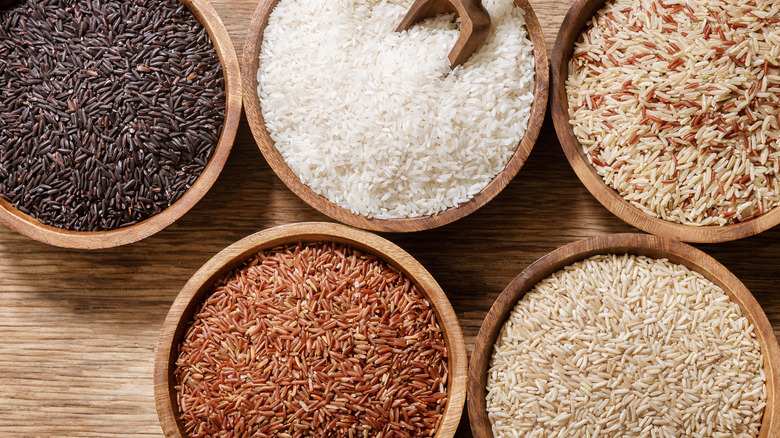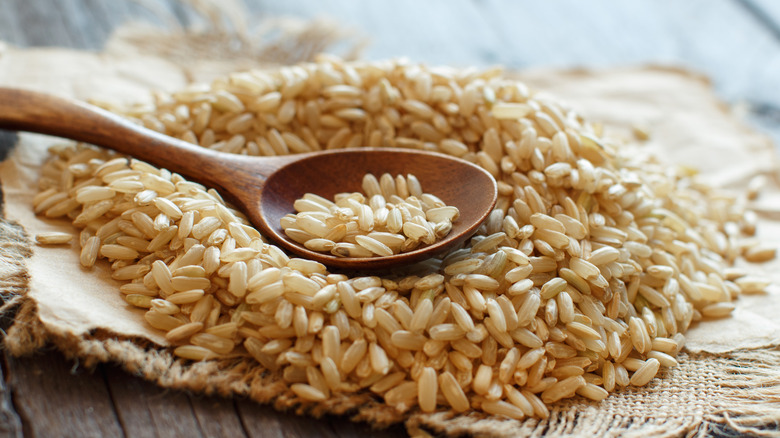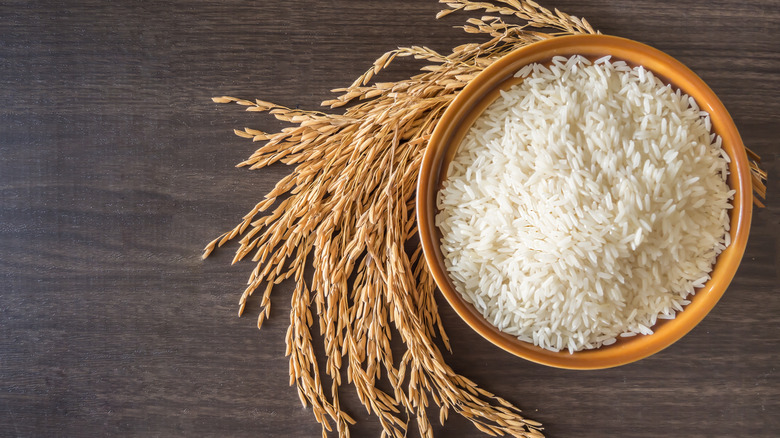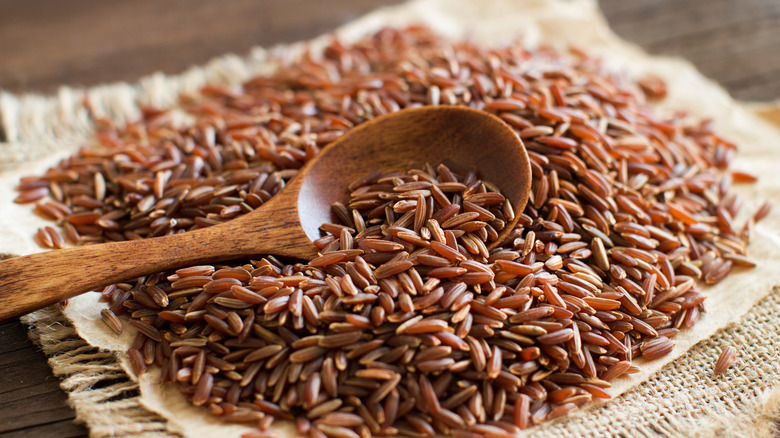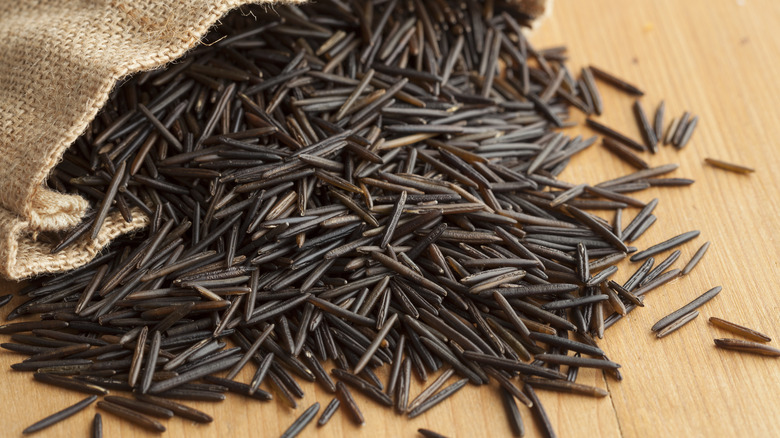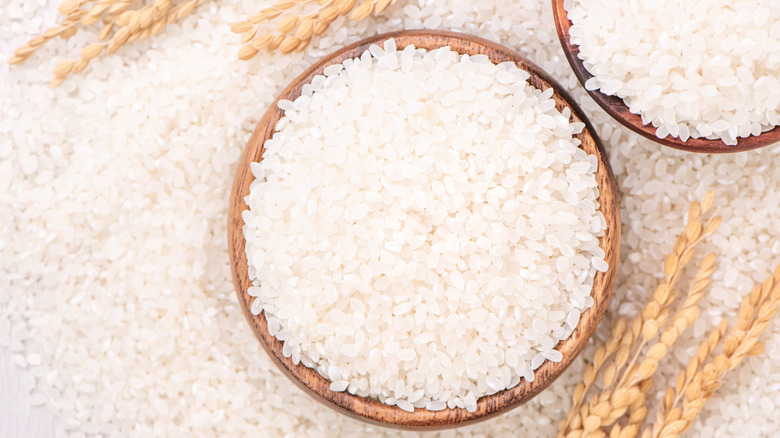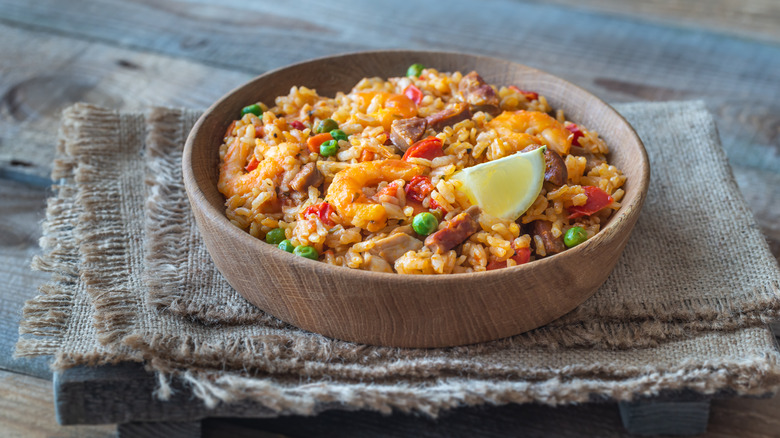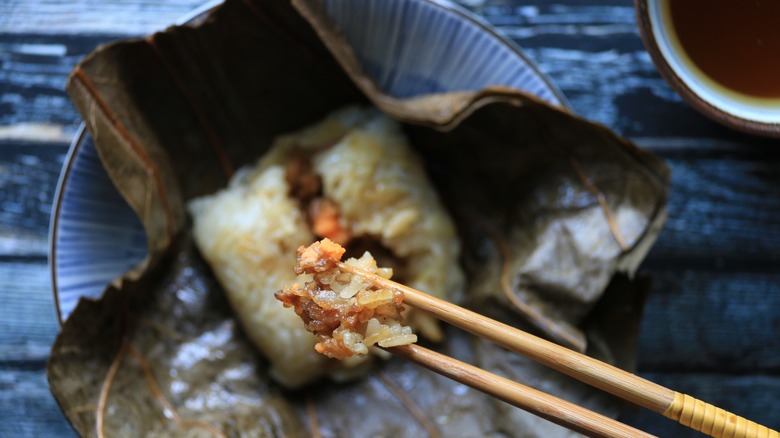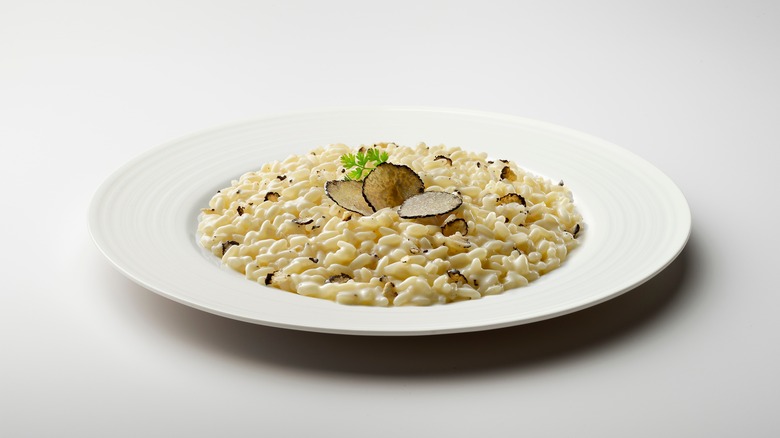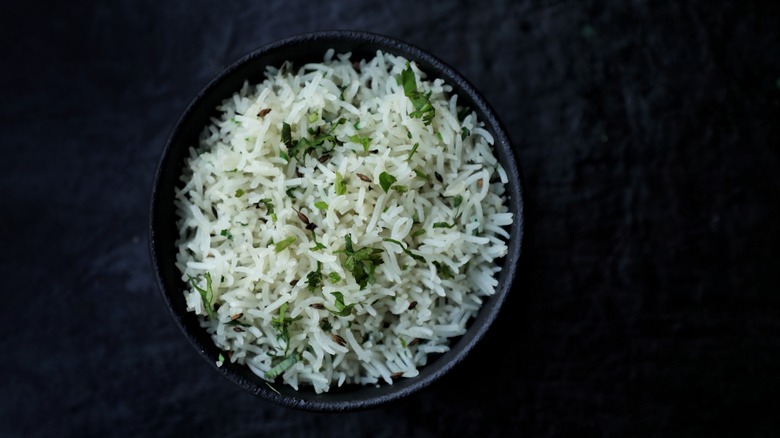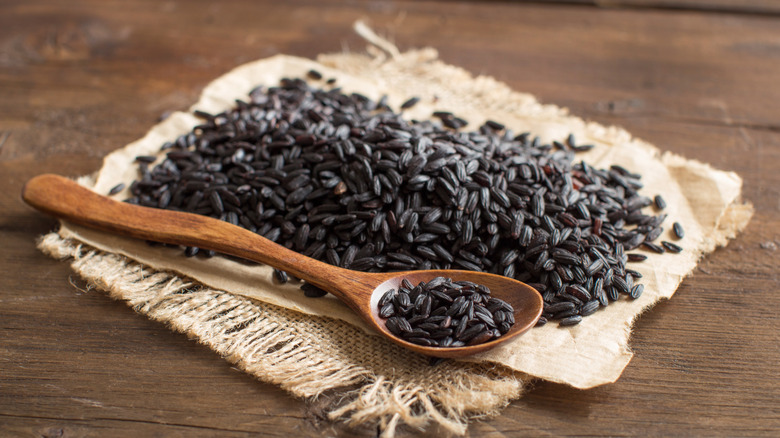Types Of Rice And How To Cook Them
Globally, rice is a staple food, so much so that there are some cultures where it's unheard of to serve a meal without any. While rice is familiar to almost everyone, it's a surprisingly complicated foodstuff. There are over 40,000 different cultivated varieties of rice worldwide, so many that this number is their best approximation. Types of rice vary wildly in grain size, shape, aroma, and flavor. The unique history of rice farming deeply ingrains it into cultural practices. Rice was first grown at least 9,400 years ago in (what we now know as) China, meaning rice's cultivation predates written history! No wonder why it's such a complicated and storied crop.
Most rice in supermarkets is likely to be simple American long-grain rice, a general-purpose white rice served with most dishes. However, choosing and properly cooking specific rice varieties can transform a good meal into something delicious. You may find several different types of rice on sale in your local grocery store, and here are a few of the most common ones you may encounter.
Brown rice
Brown rice is easy to find and has a reputation for being a healthier alternative to white rice. Brown rice is a whole grain and less refined than white rice, leaving the outer layers of the rice grains fairly intact. This outside layer makes it richer in nutrients like magnesium, iron, and B vitamins. It also contains a plentiful amount of fiber, which can help reduce cholesterol and improve digestion. Since it's a low glycemic index food, it can also help prevent type 2 diabetes.
As with nearly all rice, it's always wise to rinse it thoroughly before cooking. The downside to brown rice is that it takes substantially longer to cook properly than white rice. To get a good texture, brown rice may need to be boiled for as long as 45 minutes to soften the fibrous bran layer on the outside of the grains. The rice bran gives brown rice not only a slightly rougher texture but a stronger, nuttier flavor. In Japanese cuisine, this flavor is a big reason to use brown rice! Japanese genmaicha includes roasted brown rice grains alongside tea leaves, imparting a distinctly soothing savory taste to the tea. Roasted brown rice can also be found in Japanese confections like cookies, perfectly blending sweetness with the rich flavor of the rice.
Jasmine rice
This beautifully aromatic rice comes from Southeast Asia, particularly Vietnam, Thailand, and Cambodia. It's sticky with long grains and the perfect accompaniment to a good Thai curry. Jasmine rice's distinctive flavor isn't added artificially: It comes from the rice cultivars, giving the grains their fragrance and a slightly sweet taste. It's also lauded as healthier than other varieties of white rice — containing plentiful amounts of iron, fiber, and folic acid.
Jasmine rice can be cooked in a way similar to other types of rice. In Southeast Asia, the usual cooking method is to steam it. Additionally, it's common to add more ingredients to flavor the rice. Coconut rice is a popular choice, easily made by boiling the rice with coconut milk. Another popular choice is to add some fresh pandan leaf or a drop of pandan extract. Pandan is a type of fragrant palm tree. While an uncommon ingredient on Western supermarket shelves, it gives a distinctive fragrance to the cooked rice, which perfectly complements Southeast Asian cuisine. If you're looking to buy pandan extract, be careful to use only the clear variety. Some pandan extract has a bright green color, which is usually reserved for sweet dishes and cakes.
Red rice
Be careful not to confuse this with recipes for red rice like arroz rojo in Mexican cuisine. These kinds of dishes add ingredients to tint the finished rice dish a bright red, but red rice is literally rice with a natural red color. The rich red color of red rice comes from anthocyanins, brightly colored antioxidant molecules responsible for the vibrant hues of ripe fruits and fresh flowers.
To show off its fabulous color, red rice is usually sold whole grain like brown rice, or partially milled, so it retains a grainy pink appearance. Mostly coming from Bhutan, Thailand, and West Africa, red rice tends to have a subtly different flavor than other rice — slightly sweet but less nutty than brown rice. The big thing shared in common with brown rice is its long cooking time. Being a whole grain, it can take 30-40 minutes to cook for a good texture. The finished rice will be tender on the inside, but with a slightly chewy exterior. It can be used effectively for essentially any rice bowl dish, to add a unique color in place of the usual white or brown, or mixed with white rice as an attractive side dish — just be careful to cook the white and red rice separately due to their differing cooking times. Cooked in the same pan, white rice will boil into mush long before red rice reaches its best texture.
Manoomin
Often called wild rice or giant rice in the English-speaking world, manoomin is native to North America. It's a sacred food to the Ojibwe people of the Great Lakes region where the rice grows. According to the Indigenous legend, when people were first traveling to the region, they were told to seek "food that grows on water." When they discovered manoomin growing in pools of water with its grains ripening above the surface, they knew they found their home.
Manoomin is not a rice variety, though it's quite closely related. A nutritious grain, it cooks a bit differently from varieties of true rice. The first step is to add manoomin to a pan of water and remove anything which floats to the top. The manoomin can be washed like other rice, and then boiled with a little butter until the grains swell and burst. The exact timing may vary, depending on where the manoomin was collected. It's advised to check it after about half an hour, but it may easily take up to a full hour to cook properly. The traditional method is to add enough water that the manoomin will soak it all up when it's finished cooking. When done, it has a rich flavor and a distinctive fragrance, unlike any other rice. While some settlers now farm manoomin, the more ethical choice is to buy the food from Indigenous suppliers to support their traditional practices.
Sushi rice
Sushi is one of Japan's best-known foods, and the rice used to make it is distinctive. Rice is an essential staple in Japan and it's used to make a variety of things from chewy mochi sweets to the well-known Japanese rice wine — popularly known as sake (酒) in the western world. The most famous variety of rice wine actually goes by the name nihonshu (日本酒). Japanese rice is easily recognized for its short grains and how sticky it becomes when cooked. The latter part is essential, so the rice can be eaten with chopsticks. It's usually cooked by boiling or steaming it.
Rice in Japan is more complicated than it may initially seem. There are 600 varieties of rice grown in Japan, and three, in particular, are commonly used for sushi. Japanese sushi chefs likely have their preferred type, based on the texture, density, and appearance of the cooked rice. While such nuance tends to be missing from sushi rice bought in western countries, there are still a few key points to note. Sushi rice is finely polished, giving smooth, glassy-looking grains. The best quality sushi rice, uncooked, should have a few white flecks visible on its surface. If using it to make sushi, it's important to season the sushi rice with vinegar to give a good flavor to the finished dish.
Bomba rice
Paella is a famous Spanish dish, colored bright yellow with fragrant saffron and made with a variety of fresh seafood and the rich flavors of fine olive oil and sweet Mediterranean vegetables. The most important part of paella is the rice, as this determines the texture of the dish. Choosing good rice is important to make sure your paella doesn't become too sticky and starchy. If you go looking for paella rice, you're likely to find bomba rice.
Bomba rice has short grains like Japanese rice, but it's notable for being far less sticky. This means the finished rice will stay looser when fully cooked, giving a finished paella a good texture and preventing it from clumping together too much. Bomba rice expands dramatically when cooked, swelling up to four times its uncooked size and taking around 18 minutes to cook perfectly — a bit longer than most rice. Being so absorbent, it needs more liquid when cooking. But the benefit to that is it can soak up plenty of broth, making for a rich and flavorsome dish. There are a few different varieties of rice that can be used in paella, but bomba is widely considered the best and is the most popular choice.
Glutinous rice
Known as sticky rice, glutinous rice is often used in East Asian cuisine. While it's less common in the western world, it can be found in Chinese-owned supermarkets. For anyone with food intolerances, the name may give you pause, but don't worry! This rice does not contain gluten. Glutinous rice has a cloudy, milky white appearance when uncooked. The best way to cook it is to soak it overnight first. It can be boiled or steamed and takes around 15 minutes to get a good texture. It's popularly used to make desserts like mango sticky rice pudding, though it has a few savory uses too.
One popular glutinous rice dish is lo mai kai. A dim sum dish, these are balls of sticky glutinous rice stuffed with a savory filling. The main ingredient of the filling is chicken, but it can also include mushrooms, scallions, shrimp, egg, and other items. This bundle of food is then wrapped up as a parcel in a lotus leaf and steamed, similarly to the way corn tamales are cooked. While slightly involved to make, lo mai kai can be a filling food. A couple can make a satisfying lunch, and steamer baskets of them can often be found as part of a more filling dim sum dinner.
Arborio rice
A classic Italian comfort food, rich creamy risotto is an iconic dish. Easy to make, it can include a variety of ingredients. But the best risottos keep things simple. Fewer ingredients often make a better-finished meal, highlighting a few distinctive flavors. As a rice dish, the rice itself is, of course, a vital part of a good risotto. Arborio rice is the variety of choice among Italian chefs.
Arborio rice's name comes from a commune in Northwest Italy. It's starchy, which is what gives risotto its characteristic creamy texture, with short and plump grains. In fact, Arborio has some of the largest grains of any short-grain rice. While brown Arborio rice is available, white is usually preferred for a nice smooth risotto.
Unlike other types of rice, chefs advise not to rinse Arborio rice, so as not to wash away any of that precious starch. With big grains that absorb plenty of liquid, the ideal method to prepare risotto is to cook it gradually. With five parts water to every one part rice, Arborio should be cooked in a pan, adding water cup by cup and allowing it to be fully absorbed before adding more. While this method gives the creamy texture characteristic of a good risotto, Arborio rice can also be cooked like any other type of rice and used as a more general-purpose side dish.
Basmati rice
Basmati is a favorite rice of South Asia: Its name means "queen of fragrance," and this aromatic rice deserves that title. Basmati is known for its long, slender grains. Some of the varieties available in India can be much longer than most other types of long-grain rice, curling slightly when cooked. A low-starch rice, basmati grains hold their shape well. They remain free-flowing when cooked, making basmati rice excellent to enjoy with the rich spicy sauces of South Asian cuisine as they thoroughly coat the loose rice. Cooking this rice properly is key to making sure it has a good final texture. The first step is to soak the rice before cooking, giving it half an hour to a full hour to absorb water. This helps the rice properly expand when cooking. It's usually boiled with 4-5 parts of water for every 1 part of rice, with a little salt added to the water.
Plain-boiled basmati rice is a common side dish that you can find on many Indian dinner tables. But basmati can also be a base for a dish. Biriyani is a well-known spicy rice dish, and bright yellow spicy pilau rice is a popular choice of side in Indian restaurants. For more basic comfort food, it can also be cooked with ghee and spices to make a simple meal known as ghee rice.
Black rice
Black rice sometimes goes by the somewhat ominous name of "forbidden rice." Technically, this name only applies to a single variety of black rice from China. There are actually three types found in Thailand, China, and California. Similar to red rice, the black color comes from colorful antioxidant anthocyanins, which are responsible for the color of fruit like blackberries. These give the rice a black color while raw, which sometimes fades to a purple color when fully cooked. Since it's whole grain rice, it has a long cooking time — taking 30 to 60 minutes to boil to perfection. This rice has a rather nutty flavor, but the Chinese variety in particular has a slightly sweet and floral taste. Traditionally, black rice was used in Chinese medicine: As a food, it was reserved as a delicacy to be enjoyed by the nobility.
Different types of black rice have different culinary uses too. Thai black rice is sticky and appears in fragrant desserts. Chinese black rice, on the other hand, is much lower in starch, giving a non-sticky finish. The Chinese variety often makes congee, a type of hot rice porridge, and a soothing meal on a cold day. In Chinese culture, a bowl of congee is a popular meal when recovering from a cold, similar to how America uses chicken noodle soup for recovery.
